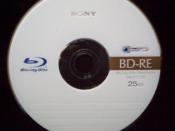Introduction
DVD or Digital Versatile Disc is an optical disc storage media format, which can be used for Data storage, high quality video and audio. DVDs resemble CDs in terms of physical dimensions being 8 to 12 cm in diameter but information is encoded in a different format and at a higher density. It utilizes a 650nm infrared laser and numerical aperture of 0.6 instead of a 780nm laser and numerical aperture of 0.45, which are used in CDs. This results in a 65% increase in read-out resolution and a 47% increase in overall efficiency when compared to CDs. (DVD Demystified, 2000)
DVD (digital versatile disc or digital video disc) technology was announced in 1995 and released in 1996 by a group of computer companies led by IBM to create a single standard format for higher density CDs (compact discs). DVD is an improvement on CDs with its storage capacity of 4.7
gigabytes, the DVD's capacity is much greater than CD's, almost by seven times. (Howstuffwork 2000)
Technological development leading to DVD
There are numerous developments of technology that led to the invention of DVD. For years, information was transported via analog signaling. This method had many problems such as degradation and corruption of data from interference and wave superposition. This happened because if an analog signal had information added to it (from interference), then the entire shape of the wave and the data carried by it, would be altered.
With the utilization of digital communication and signal transportation, and the invention of the laser has revolutionised visual and aural transmission and storage. This revolution has given way for the development of DVD technology. Furthermore, in the early 1990s, two high-density optical media storage formats were being developed and researched in order to find the successor to the...


